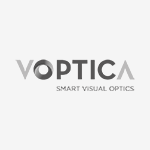Purpose: Extended depth-of-focus intraocular lenses (IOLs) and multifocal IOLs are more implanted every day as patients request to see at all distances, but some of them are associated with negative disturbances, one of the most disturbing being halos. The purpose of this work is to study the halos formation in three models of new inverted meniscus IOLs designed with aspheric optics, ArtIOLs® 25, ArtIOLs® 40 and ArtIOLs® 70 (ArtIOLs®, Voptica SL, Murcia, Spain) as compared to a standard biconvex Monofocal IOL.
Methods: The in-vitro halos were studied using a model eye with +0.28 µm corneal spherical aberration. For the study, a distant pinhole illuminated by a 530 nm LED was imaged at the retinal plane through a 4.5 mm pupil. Multiple exposure images of halos were recorded at the best focus for distance vision and fused to get a high dynamic range (HDR) image. The halos size in minute of arc and energy ratio (core vs total image) were calculated for each IOL using the HDR image of the pinhole.
Results: The pinhole image formed by the different IOLs resulted in percentage energy ratios and halos size (minutes of arc) for Monofocal Plus (ArtIOLs® 25) of 90% and 17.7ʹ, Extended depth of Focus (ArtIOLs® 40) of 87% and 17.7ʹ and Full Range of Vision (ArtIOLs® 70) of 85% 17.7ʹ, respectively. These results were comparable and similar to the ones found in a standard Monofocal IOL with energy ratios of 93% and halos size of 16.3ʹ.
Conclusions: There is no significant halos formation associated with the series of inverted meniscus lenses: Monofocal Plus (ArtIOLs® 25), Extended depth of Focus (ArtIOLs® 40) and Full Range of Vision (ArtIOLs® 70) compared to standard Monofocal lenses.
